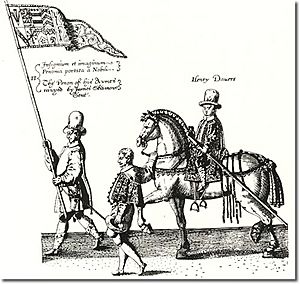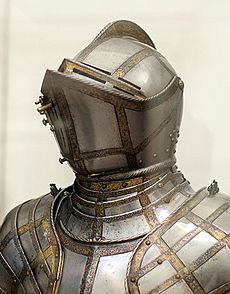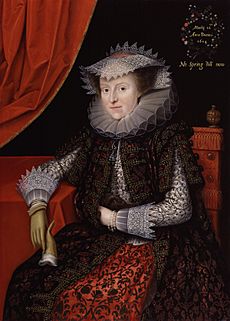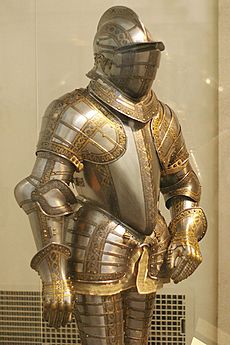James Scudamore (courtier) facts for kids
Quick facts for kids
Sir James Scudamore
|
|
|---|---|
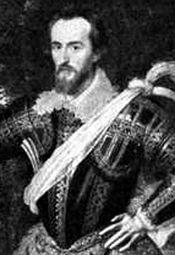
Sir James Scudamore
|
|
| Born | 1568 Holme Lacy, Herefordshire, England
|
| Died | 1619 London, England
|
| Resting place | Holme Lacy, Herefordshire, England |
| Nationality | English |
| Occupation | Courtier |
| Title | Sir |
| Predecessor | John Scudamore |
| Successor | John Scudamore, 1st Viscount Scudamore |
| Spouse(s) | Mary Houghton Mary Throckmorton |
| Children | John Scudamore, 1st Viscount Scudamore Sir James Scudamore Barnabas Scudamore |
| Parents |
|
Sir James Scudamore (1568–1619) was an important figure at the court of Queen Elizabeth I. He was known for his amazing skill in jousting (a type of knightly combat). He also showed great chivalry, which means he was brave, honorable, and polite.
James was born at Holme Lacy in Herefordshire, England. He was the oldest son of John Scudamore, who was a high-ranking official in Herefordshire. James later took over his father's role in 1616. He held this position until he passed away in 1619.
Contents
Life at Court
Sir James Scudamore became quite famous during his time at Queen Elizabeth's court. When he was young, he looked up to Philip Sidney, a famous poet, soldier, and courtier. Sidney was seen as the perfect gentleman of that era.
James wanted to be like Sidney and became his student and friend as a teenager. When Sidney died in battle in 1586, James Scudamore, who was only 18, carried his special flag (pennant of arms) at the funeral. You can see him in a drawing of the funeral procession, carrying the flag near the front.
A Knight of Chivalry
James Scudamore saw himself as Sidney's successor. He was very eager to continue the traditions of chivalry. He became well-known for his jousting skills in tournaments. He was one of the main knights who competed in the Accession Day tilt of 1595.
At this tournament, his shield had the motto "L'escu D'amour" on it. This was the old French form of his family name, meaning "shield of love." His shield was shaped like a heart and had a turtle on it.
Sir James Scudamore looked very impressive at the jousting arena. A scholar named William Higford described him like this:
A knight on horseback is the most beautiful sight the world can show. He is like a Prince... I imagine I see Sir James Scudamore... entering the Tilt yard in a fine outfit, fully armored with feathers. His helmet was closed, and he rode a very high, bouncing horse. I have seen his horse's shoes sparkle above everyone's heads. And when he went to fight, he broke as many spears as the best knights. Queen Elizabeth, with many ladies like stars in the sky, and the whole court, watched him with great favor. And when he stayed with Sir John Scudamore, his father (I will never see two braver gentlemen together, especially a son and a father)... Holme Lacy at that time seemed not only a school but even a Prince's court.
Another writer, George Peele, also praised him:
L'escu d’amour, the arms of loyalty / Lodged Skydmore in his heart; and on he came, / And well and worthily behaved himself / In that day's service: short and plain to be, / No Lord nor knight more forward than was he.
Even though he wasn't the most powerful nobleman, he was greatly admired for his sporting talent. His armor shows he was strong and tall for his time. He won first place in the Accession Day tilt at least once. The fact that the Queen herself visited Scudamore's jousting grounds at Holme Lacy shows how respected he was.
He was also a skilled soldier. He fought in the Capture of Cadiz, where he was made a knight by the Earl of Essex.
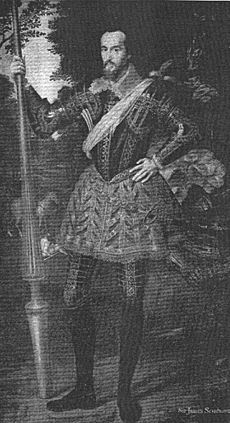
Inspiration for Literature
Sir James Scudamore is thought to be the inspiration for the character "Scudamour" in The Faerie Queene by Edmund Spenser. In this poem, Scudamour is a brave knight whose true love, Amoret, has been taken from him. He spends the rest of the story trying to find her. It's not clear if this character was meant to be a joke, a mockery, or a true picture of his chivalry.
Scudamore stopped jousting in 1600. However, he and his father continued to train horses at their home, Holme Lacy.
Political Life
Sir James Scudamore took on several important political roles. On August 25, 1600, he became the deputy lieutenant of Herefordshire. He was also made High Sheriff of Herefordshire in 1601.
He served as a member of Parliament for Herefordshire in 1601 and for several years after that. In 1617, he joined the council of the Welsh Marches. He also invested money in the Virginia Company, which helped set up colonies in America.
Religious Change
Scudamore was born into a Catholic family. However, he and his father later changed their religion. After this, he became very against Catholicism. On June 19, 1605, he and three other officials searched for Catholics along the border of Herefordshire and Monmouthshire.
They searched homes and villages all night and into the next day. They found religious items but no Catholics, as they had already left the area.
Family and Friends
In March 1597, Scudamore married Mary Houghton. She was the daughter of a London official. Sadly, she died in August 1598. Later that summer, he married another woman also named Mary, who was the widow of Sir Thomas Baskerville.
This second marriage was difficult. Sir James's family did not like Mary and pressured them to separate, which they did in 1604.
Sir James and his second wife had three sons: John (1601–1671), James (1606–1631), and Barnabas (1609–1652). His oldest son, John, took over his father's political roles and became the 1st Viscount Scudamore. His son James fought in wars in the Low Countries, and Barnabas served as a soldier at the Battle of Newburn.
A Man of Culture
Scudamore was a cultured man who supported writers and thinkers. He was a great friend of the scholar Thomas Bodley. He also helped with the founding of the famous Bodleian Library at Oxford University.
Sir James was very close with his father, John. They lived together at Holme Lacy for James's entire life. There, they trained horses and hosted many important cultural figures. These guests included Thomas Bodley, scientist John Dee, and mathematician Thomas Allen.
Because of these visitors, the Scudamores were aware of many new scientific ideas of their time. Once, Thomas Allen was visiting and showing off his pocket watch. At that time, pocket watches were very new and rare. A maid was scared by the loud ticking sound and threw the watch into a nearby stream!
Even though Herefordshire was seen as a bit old-fashioned, the Scudamore family's support of learned people gave them high social standing and a special place at the Queen's court.
The exact reason for Sir James Scudamore's death is not known. It might have been due to problems from an old leg injury. His father lived four years longer than him. In his will, Sir James left "My armor that I used to Weare" to his son John.
Sir James Scudamore's Armour
Sir James Scudamore owned some of the best surviving suits of armor from Elizabethan England. They were made at the royal Greenwich armoury. His tournament armor has a unique helmet with a high visor. It also has special leg and thigh armor. The armor is decorated with blue steel strips and fancy gold designs.
Another suit of his armor, made for a type of cavalry soldier called a cuirassier, has a different helmet with a visor that can drop down. This armor also has detailed gold patterns. A painting of Scudamore shows him wearing this armor. It's clear from the painting that the armor was originally dark. During its restoration, it was polished down to bare steel.
Discovery and Restoration
Scudamore's suits of armor were found in 1911. They were packed away in a chest in the attic of an old tower at Holme Lacy. They were in very bad shape, badly rusted. They had probably been there for hundreds of years, with water dripping onto them.
The owner of the estate at the time, Lord Chesterfield, tried to sell the armor for just twenty pounds. A dealer saw it and told Chesterfield it was worth much more. The dealer then bought it for two thousand pounds. Later, Chesterfield saw the same armor for sale in that dealer's shop for fifteen thousand pounds!
Chesterfield sued the dealer, and the armor was returned to him. The suits of armor were later bought by J. Pierpont Morgan and given to the Metropolitan Museum of Art in New York City. There, they were carefully restored. Any missing parts were replaced with new copies. Today, these amazing suits of armor are still on display.
| Political offices | ||
|---|---|---|
| Preceded by Sir John Scudamore |
Custos Rotulorum of Herefordshire 1616–1619 |
Succeeded by Sir John Scudamore |


